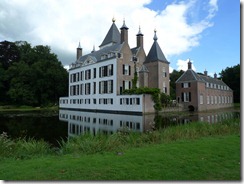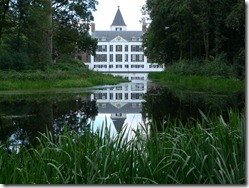
It's not all about beer, but it does play a part.
We're back in N.'s ancestral village in the West Bank, having crossed into Palestine from Jordan at the Allenby Bridge yesterday. The crossing went easily enough, although we had to invest some four hours to the process. There was apparently some security concern on the Israeli side of the border that locked up their terminal for an hour or so, which also delayed the bus taking us from the Jordan side.
We were early at the Bridge because it was Saturday; the crossing only operates a half-day for the Jewish Shabbat. This meant an early arrival at the Bridge was required. That it was open at all on the holy day is a relatively recent event. In the bad old days it was closed from mid-Fridays to Sunday.
No matter how much they make it resemble an airport, the Allenby Bridge crossing will always be complicated by all the security steps taken on both sides of the border. However, even with multiple luggage checks, four or five passport reviews plus immigration, and a somewhat chaotic final luggage inspection and x-ray, I've experienced worse border formalities. The problem is that, although the system is essentially simple, it is not scalable to handle larger groups of people efficiently. If there are several tourist buses at one time, the process degenerates into a mad scramble for position and privilege. Tourists on buses are insulated from the melee, for the most part, but with the heat, noise, smells and confusion, crossing is not pleasant for anyone. It does make a good story for your next cocktail party, however.
An early start did help, as we arrived in Taybeh (pronounced "Tai-beh") in time for the beginning of the festivities. The idea of an Oktoberfest in a small, Palestinian village may seem strange, but it works very well for Taybeh. The small town is home to the only beer brewery in Palestine (Christians can drink alcohol, for the most part), and Taybeh Beer is the festival's primary, but not sole, sponsor. Every year has seen the festival grow, and this year the traditional venue has reach the bursting point. Evenings are given over to rock bands and similar entertainment, and the small, outdoor court holding both stage and audience offers standing-room only—if you stand on one foot. Plastic chairs are at a premium, and are scattered as the crowd sees fit. The crowding seems to be part of the charm for the young, but I understand that plans are in place to move into the surrounding streets and expand the venue dramatically for 2011.
I'm not too sure that expansion is a good idea. The festival is becoming too large for Taybeh and will inevitably attract the wrong kind of attention. I understand they are already having problems with vandals and unruly behavior. This is to be expected because of the alcohol and presence of a lot of young persons. The festival is a bright and solitary spot on the social calendar so it draws many from surrounding villages.
There was a strong police presence from the PA but the force, and the organizer, seems to have been surprised by the turnout. Far better planning is necessary for future events, along with parking plans, directional signs, better lighting, segregated food stands, spreading craft sellers around the area, and even more police presence. Did I mention PARKING PLANS?
It's an international party, with everything from a Karate demonstration to a Sri Lankan cultural dance. High points included the claimed first Palestinian rock-rap group, a doubtful premier achievement in my view, and a complete Taybeh wedding celebration, which N. says was truly excellent. (I fortunately missed it by enjoying a cigar and a Taybeh beer under T.'s wonderful fig tree. I've had enough of weddings for this year.) Throw in local crafts and produce booths (olives, oil, spices, etc.) and you can sense that it's quite a two-day party. You can even buy a T-shirt.
People come from all over to this event, and not just from Palestine; many European countries provided tourists on the first day, and several consulates with representatives to the Palestine National Authority were also present, along with their security contingents. Even the U.S. consul was present with American families and a line of black SUVs. (Are these things available in any other color?)
T. and his wife, E. use the event for a massive open house for hundreds of friends and locals. He provides an enormous amount of food and drink (lots of Taybeh beer, of course), and everyone takes the opportunity to see what they have done to their house and grounds recently. We were happy to participate and help direct a tour or two.
For me, it's a grand opportunity to sink into a soft chair, clasp a good cigar, sip a drink, commune with the ample and gentle nature all around me, and thank the fig tree above me for its shade. T. has invested in gardens and fruit trees which provide great beauty and bounty, and the gentle but persistent Taybeh breeze brushes your cheek like God's breath. This must be close to heaven; no wonder they call it the Holy Land.

